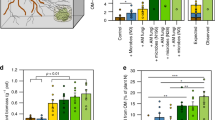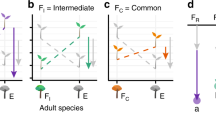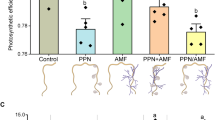Abstract
Arbuscular mycorrhizal (AM) fungi are one of the most important groups of plant symbionts. These fungi provide mineral nutrients to plants in exchange for carbon. Although substantial amounts of resources are exchanged, the factors that regulate trade in the AM symbiosis are poorly understood. Recent evidence for the reciprocally regulated exchange of resources by AM fungi and plants has led to the suggestion that these symbioses operate according to biological market dynamics, in which interactions are viewed from an economic perspective, and the most beneficial partners are favoured. Here we present five arguments that challenge the importance of reciprocally regulated exchange, and thereby market dynamics, for resource exchange in the AM symbiosis, and suggest that such reciprocity is only found in a subset of symbionts, under specific conditions. We instead propose that resource exchange in the AM symbiosis is determined by competition for surplus resources, functional diversity and sink strength.
This is a preview of subscription content, access via your institution
Access options
Subscribe to this journal
Receive 12 digital issues and online access to articles
$119.00 per year
only $9.92 per issue
Buy this article
- Purchase on Springer Link
- Instant access to full article PDF
Prices may be subject to local taxes which are calculated during checkout


Similar content being viewed by others
References
Fitter, A. H. Darkness visible: reflections on underground ecology. J. Ecol. 93, 231–243 (2005).
Wang, B. & Qiu, Y. L. Phylogenetic distribution and evolution of mycorrhizas in land plants. Mycorrhiza 16, 299–363 (2006).
Drigo, B., Pijl, A. & Duyts, H. Shifting carbon flow from roots into associated microbial communities in response to elevated atmospheric CO2 . Proc. Natl Acad. Sci. 107, 10938–10942 (2010).
Van der Heijden, M. G. A., Martin, F. M., Selosse, M.-A. & Sanders, I. R. Mycorrhizal ecology and evolution: the past, the present, and the future. New Phytol. 205, 1406–1423 (2015).
Smith, S. E. & Read, D. J. Mycorrhizal Symbiosis. (Academic, 2008).
Selosse, M.-A. & Le Tacon, F. The land flora: A phototroph-fungus partnership? Trends Ecol. Evol. 13, 15–19 (1998).
Kiers, E. T. & Denison, R. F. Sanctions, cooperation, and the stability of plant-rhizosphere mutualisms. Annu. Rev. Ecol. Evol. Syst. 39, 215–236 (2008).
Hoeksema, J. D. et al. A meta-analysis of context-dependency in plant response to inoculation with mycorrhizal fungi. Ecol. Lett. 13, 394–407 (2010).
Klironomos, J. Variation in plant response to native and exotic arbuscular mycorrhizal fungi. Ecology 84, 2292–2301 (2003).
Johnson, N. C., Graham, J. H. & Smith, F. A. Functioning of mycorrhizal associations along the mutualism-parasitism continuum. New Phytol. 135, 575–586 (1997).
Bever, J. D., Morton, J. B., Antonovics, J. & Schultz, P. A. Host-dependent sporulation and species diversity of arbuscular mycorrhizal fungi in a mown grassland. J. Ecol. 84, 71–82 (1996).
Kiers, E. T. et al. Reciprocal rewards stabilize cooperation in the mycorrhizal symbiosis. Science 333, 880–882 (2011).
Noë, R. & Hammerstein, P. Biological markets. Trends Ecol. Evol. 10, 336–9 (1995).
Schwartz, M. W. & Hoeksema, J. D. Specialization and resource trade: Biological markets as a model of mutualisms. Ecology 79, 1029–1038 (1998).
Werner, G. D. A. et al. Evolution of microbial markets. Proc. Natl Acad. Sci. 111, 1237–1244 (2014).
Axelrod, R. & Hamilton, W. D. The evolution of cooperation. Science 211, 1390–1396 (1981).
Selosse, M.-A. & Rousset, F. The plant-fungal marketplace. Science 333, 828–829 (2011).
Archetti, M. & Scheuring, I. Coexistence of cooperation and defection in public goods games. Evolution 65, 1140–8 (2011).
Bücking, H. & Shachar-Hill, Y. Y. Phosphate uptake, transport and transfer by the arbuscular mycorrhizal fungus Glomus intraradices is stimulated by increased carbohydrate availability. New Phytol. 165, 899–912 (2005).
Lekberg, Y., Hammer, E. C. & Olsson, P. A. Plants as resource islands and storage units - adopting the mycocentric view of arbuscular mycorrhizal networks. FEMS Microbiol. Ecol. 74, 336–345 (2010).
Hammer, E. C., Pallon, J., Wallander, H. & Olsson, P. A. Tit for tat? A mycorrhizal fungus accumulates phosphorus under low plant carbon availability. FEMS Microbiol. Ecol. 76, 236–244 (2011).
Fellbaum, C. R. et al. Carbon availability triggers fungal nitrogen uptake and transport in arbuscular mycorrhizal symbiosis. Proc. Natl Acad. Sci. 109, 2666–2671 (2012).
Fellbaum, C. R. et al. Fungal nutrient allocation in common mycorrhizal networks is regulated by the carbon source strength of individual host plants. New Phytol. 203, 646–656 (2014).
Bever, J. D., Richardson, S. C., Lawrence, B. M., Holmes, J. & Watson, M. Preferential allocation to beneficial symbiont with spatial structure maintains mycorrhizal mutualism. Ecol. Lett. 12, 13–21 (2009).
Fitter, A. H. What is the link between carbon and phosphorus fluxes in arbuscular mycorrhizas? A null hypothesis for symbiotic function. New Phytol. 172, 3–6 (2006).
Drew, M. C. Comparison of effects of a localized supply of phosphate, nitrate, ammonium and potassium on growth of seminal root system, and shoot, in barley. New Phytol. 75, 479–490 (1975).
Leake, J. R. Myco-heterotroph/epiparasitic plant interactions with ectomycorrhizal and arbuscular mycorrhizal fungi. Curr. Opin. Plant Biol. 7, 422–428 (2004).
Courty, P.-E. et al. Carbon and nitrogen metabolism in mycorrhizal networks and mycoheterotrophic plants of tropical forests: a stable isotope analysis. Plant Physiol. 156, 952–961 (2011).
Imhof, S. Root morphology, anatomy and mycotrophy of the achlorophyllous Voyria aphylla (Jacq.) Pers.(Gentianaceae). Mycorrhiza 9, 33–39 (1999).
Peng, S., Eissenstat, D. M., Graham, J. H., Williams, K. & Hodge, N. C. Growth depression in mycorrhizal citrus at high-phosphorus supply (analysis of carbon costs). Plant Physiol. 101, 1063–1071 (1993).
Wilson, G. W. T. & Hartnett, D. C. Interspecific variation in plant responses to mycorrhizal colonization in tallgrass prairie. Am. J. Bot. 85, 1732–1738 (1998).
Veiga, R. S. L., Jansa, J., Frossard, E. & van der Heijden, M. G. A. Can arbuscular mycorrhizal fungi reduce the growth of agricultural weeds? PLoS ONE 6, e27825 (2011).
Smith, S. E., Smith, F. A. & Jakobsen, I. Functional diversity in arbuscular mycorrhizal (AM) symbioses: the contribution of the mycorrhizal P uptake pathway is not correlated with mycorrhizal responses in growth or total P uptake. New Phytol. 162, 511–524 (2004).
Grace, E. J., Cotsaftis, O., Tester, M., Smith, F. A. & Smith, S. E. Arbuscular mycorrhizal inhibition of growth in barley cannot be attributed to extent of colonization, fungal phosphorus uptake or effects on expression of plant phosphate transporter genes. New Phytol. 181, 938–49 (2009).
Lekberg, Y. & Koide, R. T. Integrating physiological, community, and evolutionary perspectives on the arbuscular mycorrhizal symbiosis. Botany 92, 241–251 (2014).
Sanders, I. R. in Mycorrhizal Ecology (eds Van der Heijden, M. G. A. & Sanders, I. R. ), 415–440 (Springer, 2002).
Law, R. & Koptur, S. On the evolution of non-specific mutualism. Biol. J. Linn. Soc. 27, 251–267 (1986).
Bshary, R. & Bronstein, J. L. Game structures in mutualistic interactions: what can the evidence tell us about the kind of models we need? Adv. Study Behav. 34, 59–101 (2004).
Kiers, E. T., Rousseau, R. A., West, S. A. & Denison, R. F. Host sanctions and the legume–rhizobium mutualism. Nature 425, 78–81 (2003).
Pellmyr, O. & Huth, C. J. Evolutionary stability of mutualism between yuccas and yucca moth. Nature 372, 257–260 (1994).
Jandér, K. C. & Herre, E. A. Host sanctions and pollinator cheating in the fig tree–fig wasp mutualism. Proc. R. Soc. Biol. Sci. 277, 1481–1488 (2010).
Poisot, T., Bever, J. D., Nemri, A., Thrall, P. H. & Hochberg, M. E. A conceptual framework for the evolution of ecological specialisation. Ecol. Lett. 14, 841–51 (2011).
Brundrett, M. C. Mycorrhizal associations and other means of nutrition of vascular plants: understanding the global diversity of host plants by resolving conflicting information and developing reliable means of diagnosis. Plant Soil 320, 37–77 (2009).
Öpik, M. et al. Global sampling of plant roots expands the described molecular diversity of arbuscular mycorrhizal fungi. Mycorrhiza 23, 411–30 (2013).
Kõljalg, U. et al. Towards a unified paradigm for sequence-based identification of fungi. Mol. Ecol. 22, 5271–5277 (2013).
Helgason, T. et al. Selectivity and functional diversity in arbuscular mycorrhizas of co-occurring fungi and plants from a temperate deciduous woodland. J. Ecol. 90, 371–384 (2002).
Vandenkoornhuyse, P., Ridgway, K. P., Watson, I. J., Fitter, A. H. & Young, J. P. W. Co-existing grass species have distinctive arbuscular mycorrhizal communities. Mol. Ecol. 12, 3085–3095 (2003).
Ohsowski, B. M., Zaitsoff, P. D., Öpik, M. & Hart, M. M. Where the wild things are: looking for uncultured Glomeromycota. New Phytol. 204, 171–179 (2014).
Helgason, T. & Fitter, A. H. Natural selection and the evolutionary ecology of the arbuscular mycorrhizal fungi (Phylum Glomeromycota). J. Exp. Bot. 60, 2465–2480 (2009).
Öpik, M., Metsis, M. & Daniell, T. J. Large-scale parallel 454 sequencing reveals host ecological group specificity of arbuscular mycorrhizal fungi in a boreonemoral forest. New Phytol. 184, 424–437 (2009).
Torrecillas, E., Alguacil, M. M. & Roldán, a. Host preferences of arbuscular mycorrhizal fungi colonizing annual herbaceous plant species in semiarid Mediterranean prairies. Appl. Envir. Microbiol. 78, 6180–6 (2012).
Montesinos-Navarro, A., Segarra-Moragues, J. G., Valiente-Banuet, A. & Verdú, M. The network structure of plant–arbuscular mycorrhizal fungi. New Phytol. 194, 536–547 (2012).
Van der Heijden, M. G. A. et al. Mycorrhizal fungal diversity determines plant biodiversity, ecosystem variability and productivity. Nature 396, 69–72 (1998).
Bever, J. D. et al. Rooting theories of plant community ecology in microbial interactions. Trends Ecol. Evol. 25, 468–478 (2010).
Newman, E. I. Mycorrhizal links between plants: their functioning and ecological signifcance. Adv. Ecol. Res. 18 243–270 (1988).
Hart, M. M. et al. Hiding in a crowd—does diversity facilitate persistence of a low-quality fungal partner in the mycorrhizal symbiosis? Symbiosis 59, 47–56 (2012).
Smith, F. A. & Smith, S. E. Mutualism and parasitism: diversity in function and structure in the “arbuscular” (VA) mycorrhizal symbiosis. Adv. Bot. Res. 22, 1–43 (1996).
Harrison, M. J., Dewbre, G. R. & Liu, J. Y. A phosphate transporter from Medicago truncatula involved in the acquisiton of phosphate released by arbuscular mycorrhizal fungi. Plant Cell 14, 2413–2429 (2002).
Kobae, Y., Tamura, Y., Takai, S., Banba, M. & Hata, S. Localized expression of arbuscular mycorrhiza-inducible ammonium transporters in soybean. Plant Cell Physiol. 51, 1411–1415 (2010).
Hodge, A., Helgason, T. & Fitter, A. H. Nutritional ecology of arbuscular mycorrhizal fungi. Fungal Ecol. 3, 267–273 (2010).
Helber, N. et al. A versatile monosaccharide transporter that operates in the arbuscular mycorrhizal fungus Glomus sp is crucial for the symbiotic relationship with plants. Plant Cell 23, 3812–3823 (2011).
Floss, D. S., Levy, J. G., Lévesque-Tremblay, V., Pumplin, N. & Harrison, M. J. DELLA proteins regulate arbuscule formation in arbuscular mycorrhizal symbiosis. Proc. Natl Acad. Sci. 110, E5025–E5034 (2013).
Walder, F. et al. Mycorrhizal networks: common goods of plants shared under unequal terms of trade. Plant Physiol. 159, 789–797 (2012).
Grime, J. P., Mackey, J. M. L., Hillier, S. H. & Read, D. J. Floristic diversity in a model system using experimental microcosms. Nature 328, 420–422 (1987).
Munkvold, L., Kjøller, R., Vestberg, M., Rosendahl, S. & Jakobsen, I. High functional diversity within species of arbuscular mycorrhizal fungi. New Phytol. 164, 357–364 (2004).
Koch, A. M. et al. High genetic variability and low local diversity in a population of arbuscular mycorrhizal fungi. Proc. Natl Acad. Sci. 101, 2369–2374 (2004).
Ravnskov, S. & Jakobsen, I. Functional compatibility in arbuscular mycorrhizas measured as hyphal P transport to the plant. New Phytol. 129, 611–618 (1995).
Lendenmann, M. et al. Symbiont identity matters: carbon and phosphorus fluxes between Medicago truncatula and different arbuscular mycorrhizal fungi. Mycorrhiza 21, 689–702 (2011).
Smith, S. E., Jakobsen, I., Gronlund, M. & Smith, F. A. Roles of arbuscular mycorrhizas in plant phosphorus nutrition: Interactions between pathways of phosphorus uptake in arbuscular mycorrhizal roots have important implications for understanding and manipulating plant phosphorus acquisition. Plant Physiol. 156, 1050–1057 (2011).
Newsham, K., Fitter, A. H. & Watkinson, A. R. Multi-funcionality and biodiversity in arbuscular micorrhizas. Trends Ecol. Evol. 10, 407–411 (1995).
Jandér, C. K., Herre, E. A., Simms, E. L. & Irwin, R. Precision of host sanctions in the fig tree-fig wasp mutualism: consequences for uncooperative symbionts. Ecol. Lett. 15, 1362–9 (2012).
Heil, M. et al. Divergent investment strategies of Acacia myrmecophytes and the coexistence of mutualists and exploiters. Proc. Natl Acad. Sci. 106, 18091–18096 (2009).
Grman, E. Plant species differ in their ability to reduce allocation to non-beneficial arbuscular mycorrhizal fungi. Ecology 93, 711–718 (2012).
Zheng, C., Ji, B., Zhang, J., Zhang, F. S. & Bever, J. D. Shading decreases plant carbon preferential allocation towards the most beneficial mycorrhizal mutualist. New Phytol. 205, 361–368 (2015).
Bever, J. D. Soil community feedback and the coexistence of competitiors: conceptual framewords and empirical tests. New Phytol. 157, 465–473 (2003).
Bever, J. D. Negative feedback within a mutualism: host-specific growth of mycorrhizal fungi reduces plant benefit. Proc. R. Soc. Lond. B 269, 2595–2601 (2002).
Fortin, J. A. et al. Arbuscular mycorrhiza on root-organ cultures. Can. J. Bot. 80, 1–20 (2002).
Bever, J. D. Preferential allocation, physio-evolutionary feedbacks, and the stability and environmental patterns of mutualism between plants and their root symbionts. New Phytol. 205, 1503–1514 (2015).
Simard, S. W. & Durall, D. M. Mycorrhizal networks: a review of their extent, function, and importance. Can. J. Bot. 82, 1140–1165 (2004).
Kytoviita, M. M., Vestberg, M. & Tuom, J. A test of mutual aid in common mycorhizal networks: established vegetation negates benefit in seedlings. Ecology 84, 898–906 (2003).
Merrild, M. P., Ambus, P., Rosendahl, S. & Jakobsen, I. Common arbuscular mycorrhizal networks amplify competition for phosphorus between seedlings and established plants. New Phytol. 200, 229–40 (2013).
Weremijewicz, J. & Janos, D. P. Common mycorrhizal networks amplify size inequality in Andropogon gerardii monocultures. New Phytol. 198, 203–13 (2013).
Walder, F. et al. Plant phosphorus acquisition in a common mycorrhizal network: regulation of phosphate transporter genes of the Pht1 family in sorghum and flax. New Phytol. 205, 1632–1645 (2015).
Egger, K. N. & Hibbett, D. S. D. S. The evolutionary implications of exploitation in mycorrhizas. Can. J. Bot. 82, 1110–1121 (2004).
Corrêa, A., Gurevitch, J., Martins-Loucao, M. A. & Cruz, C. C allocation to the fungus is not a cost to the plant in ectomycorrhizae. Oikos 121, 449–463 (2012).
Bryla, D. R. & Eissenstat, D. M. in Advances in Photosynthesis and Respiration (eds Lambers, H. & Ribas-Carbo, H. ) 207–224 (Springer, 2005).
Poorter, H. & De Jong, R. O. B. A comparison of specific leaf area, chemical composition and leaf construction costs of field plants from 15 habitats differing in productivity. New Phytol. 143, 163–176 (1999).
Kiers, E. T. & van der Heijden, M. G. A. Mutualistic stability in the arbuscular mycorrhizal symbiosis: exploring hypotheses of evolutionary cooperation. Ecology 87, 1627–1636 (2006).
Corrêa, A., Cruz, C. & Ferrol, N. Nitrogen and carbon/nitrogen dynamics in arbuscular mycorrhiza: the great unknown. Mycorrhiza http://dx.doi.org/10.1007/s00572-015-0627-6 (2015)
Smith, F. A. & Smith, S. E. How harmonious are arbuscular mycorrhizal symbioses? Inconsistent concepts reflect different mindsets as well as results. New Phytol. 205, 1381–1384 (2015).
Archetti, M. & Scheuring, I. Trading public goods stabilizes interspecific mutualism. J. Theor. Biol. 318, 58–67 (2013).
Fayle, T. M. et al. Public goods, public services and by-product mutualism in an ant-fern symbiosis. Oikos 121, 1279–1286 (2012).
Johnson, N. C. Resource stoichiometry elucidates the structure and function of arbuscular mycorrhizas across scales. New Phytol. 185, 631–647 (2010).
Johnson, N. C., Wilson, G. W. T., Bowker, M. A., Wilson, J. A. & Miller, R. M. Resource limitation is a driver of local adaptation in mycorrhizal symbioses. Proc. Natl Acad. Sci. 107, 2093–2098 (2010).
Bronstein, J. L. The exploitation of mutualisms. Ecol. Lett. 4, 277–287 (2001).
Van der Heijden, M. G. A. & Horton, T. R. Socialism in soil? The importance of mycorrhizal fungal networks for facilitation in natural ecosystems. J. Ecol. 97, 1139–1150 (2009).
Field, K. J. et al. From mycoheterotrophy to mutualism: mycorrhizal specificity and functioning in Ophioglossum vulgatum sporophytes. New Phytol. 205, 1492–1502 (2015).
Palmer, T. M. et al. Synergy of multiple partners, including freeloaders, increases host fitness in a multispecies mutualism. Proc. Natl Acad. Sci. 107, 17234–9 (2010).
Acknowledgements
We thank S. Pellkofer and K. Hartman for assistance in copyediting the manuscript, and Manu Magic Meyer for contributing artwork for Fig. 2. We also thank A. Fitter for constructive comments. This work was supported by Agroscope, the Swiss National Science Foundation (grant 143097) and the EU project OSCAR.
Author information
Authors and Affiliations
Contributions
F.W. and M.G.A.v.d.H. co-wrote and edited the paper and generated the figures.
Corresponding authors
Ethics declarations
Competing interests
The authors declare no competing interests.
Supplementary information
Rights and permissions
About this article
Cite this article
Walder, F., van der Heijden, M. Regulation of resource exchange in the arbuscular mycorrhizal symbiosis. Nature Plants 1, 15159 (2015). https://doi.org/10.1038/nplants.2015.159
Received:
Accepted:
Published:
DOI: https://doi.org/10.1038/nplants.2015.159
This article is cited by
-
Phytophagy impacts the quality and quantity of plant carbon resources acquired by mutualistic arbuscular mycorrhizal fungi
Nature Communications (2024)
-
Mutualism at the leading edge: insights into the eco-evolutionary dynamics of host-symbiont communities during range expansion
Journal of Mathematical Biology (2024)
-
Soil microbiome indicators can predict crop growth response to large-scale inoculation with arbuscular mycorrhizal fungi
Nature Microbiology (2023)
-
Quantification of arbuscular mycorrhizal fungi root colonization in wheat, tomato, and leek using absolute qPCR
Mycorrhiza (2023)
-
Endophytic Pseudomonas pseudoalcaligenes and arbuscular mycorrhizal fungi mediated anti-autophagy and induction of catalase and antioxidant enzymes in pigeon pea against fungal pathogen
Journal of Plant Pathology (2023)



